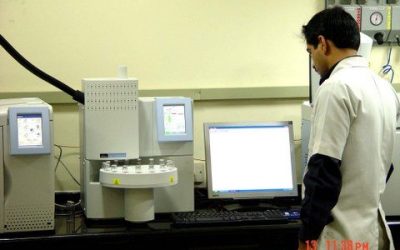The analysis of amino acids is performed for the accurate characterization of proteins and peptides. It also helps in the quantification of free amino acids present in the food samples. In 1963, the amino acid analysis was done for the first time by Moore and Stein. This analysis was performed by using ion-exchange chromatography (IEC) and post-column derivatization (PCD) with ninhydrin reagent for absorbance detection or o-phthalaldehyde for fluorescence detection. The 20 amino acids are characterized individually and separately without mixing of the sample matrix.
A process of post-column derivatization:
The protein or peptide chain is broken to release free amino acids to determine their absolute quantity in the sample.
- Ion-exchange chromatography is used for the separation of amino acids in the column.
- Ninhydrin reagent is used for the derivatization of amino acids. This is done at an elevated temperature, i.e. the mixing of amino acids with the reagent.
- Derivatization is actually done to gain selectivity and sensitivity in the analysis.
- Derivatization is performed separately for each amino acid.
- The final stage is the detection of derivatives (free amino acid) via absorption in the visible range (440 nm and 570 nm).
Advantages:
- It is a non-destructive method
- It is straight-forward and more useful than pre-column derivatization.
- It detects both primary as well as secondary amino acids.
- It also detects the derivatives of amino acids
- It can be easily automated and is a simple method.
- It has excellent quantitation performance.
Disadvantages:
- PCD is quite difficult to use for highly-sensitive analysis.
- It can use only a limited range of derivatizing reagents.
- Reverse-phase chromatography cannot be used rapidly for immediate analysis of samples.
- Reagent consumption is high.
PCD with other methods:
High-performance liquid chromatography (HPLC) was accomplished to be used with PCD. In particular, reverse-phase HPLC has given better results; therefore, it is widely used as a chromatographic technique for amino acid analysis. It requires a minimal sample for the analysis as compared w.r.t. pre-column method. HPLC is the most effective and efficient method for this purpose since it is widely used for health and functional foods.
Also, cation-exchange chromatography when used with PCD gave the most accurate and precise result for the determination of the exact composition of pure protein in food and feed samples.
Amino Acid Profile in Food Supplements
What are Food Supplements?
Food supplements, also called dietary supplements, are concentrated sources of nutrients that are meant to supplement the normal diet, which may be deficient in these nutrients.
These nutrients could be vitamins, minerals, herbal extracts, amino acids, enzymes and many other ingredients. Food supplements can help to obtain the nutrients that may be lacking in a regular diet. However, they are not intended to replace healthy meals.
These supplements can be available as tablets, capsules, powders or health drinks. Popular supplements can include a combination of any of the following components:
- Vitamins: A, D, K, B-complex, biotin (vitamin B7)
- Antioxidant Vitamins: Vitamins C, E
- Minerals: Iron, calcium, copper, phosphorus, potassium, silicon, magnesium, zinc
- Trace Elements: Boron, selenium, vanadium, nickel, chromium, iodine
- Herbs and Botanicals: Ginseng, Ginkgo biloba
- Carotenoids
- Flavonoids
- Choline
- Folic Acid
- Amino Acids: Twenty amino acids that act as the building blocks of a vast number of proteins
- Glucosamine
- Lycopene
- Lutein
- Probiotics: Lactobacillus
- Fish Oil Derivatives: Omega-3 fatty acids, omega-6 fatty acids, docosahexaenoic acid (DHA), eicosapentaenoic acid (EPA)
Why is the Amino Acid Profile in Food Supplements Important?
Amino acids are the building blocks of proteins that constitute the muscle mass of the body. There are 20 major amino acids in the body, which have different properties based on differences in their chemical structure. Therefore, information about the amino acid profile is very important for the consumer to make an informed choice about which product to buy. Some of the major amino acids are briefly described below:
- Tryptophan: This amino acid can produce a chemical substance called serotonin, which is a natural pain-killer in the body. Therefore, tryptophan supplementation can help to reduce pain during strenuous exercise.
- Branched-chain amino acids (BCAA): Research has shown that BCAA supplementation may delay the onset of fatigue in the central nervous system (CNS), thereby delaying mental fatigue as well, which is important for endurance sports like marathon running.
- Aspartic acid: Dietary supplementation of potassium and magnesium salts of the amino acid aspartic acid can enhance aerobic performance and endurance.
- Arginine: Research indicates that arginine supplementation could improve symptoms of heart disease including pain in the shoulder and arms (angina pain).
Package Labeling for Amino Acids
The United States Food & Drug Administration (USFDA) as per its directive [21 CFR 101.36(b)(2)(i)] stipulates that a dietary supplement containing amino acids must be labeled as such and the amino acid profile should be clearly displayed on the display panel of the package. Moreover, it should not be labeled as a protein if only amino acids are present.
How is the Amino Acid Profile Determined?
Determination of the amino acid profile of proteins and peptides present in many types of samples, including food samples like Dietary supplements, is a fundamental biochemical technique.
The number of free amino acids, as well as amino acids released from proteins and peptides, can be quantitated by the procedure of amino acid analysis. Generally, UV spectrophotometry and high-pressure liquid chromatography (HPLC) are used for determination of the amino acid profile of samples. This is done following good laboratory practices (GLP) in specialized laboratories with strict norms and standards
An amino acid analysis is a fundamental biochemical technique used for the determination of amino acid composition. Proteins and peptides are macromolecules consisting of covalently bonded amino acid residues organized as a linear polymer. The sequence of the amino acids in a protein determines the properties of the molecule. Proteins are large molecules that commonly exist as folded structures with a specific conformation while the peptides are smaller and may consist of only a few amino acids. This analysis helps us to quantify proteins and peptides based on their amino acid composition and also to evaluate fragmentation strategies for peptide mapping.
Amino acid analysis has wide applications in the Food Industry. Quantitation of amino acids released during hydrolysis is an important measure of a food product’s nutritional value. A free amino acid profile can give good insight into the origin of a food product and indirectly can also give information on possible adulteration. Further, free amino acids are also metabolic indicators that can be used to monitor and optimize the processes in the food processing domain.
An amino acid analysis is a vital tool at all stages of Drug Discovery and the manufacturing process wherein it is used to ensure consistency between drug batches. It is an important part of the ICH Q6B guidelines in support of new marketing applications.
How Can We Help?
Our laboratories in pan India locations are fully equipped for amino acid analysis in various sample matrices such as protein/peptide hydrolysates, feeds, foods and pharmaceutical preparations. The equipment here makes use of a traditional HPLC attached to a fluorescence/UV-Vis detector with a pre-column derivatization step. This provides enhanced resolution with precise qualitative and quantitative results.
We are committed to provide the latest in the field of analysis so clients can get the best analytical solutions. The new range of the amino acid analytical method is well suited for the food and pharmaceutical industry so food manufacturers, biological researchers, and developers of pharmaceutical formulations and food supplement manufacturers can use the amino acid analysis for quick identification of nutrition in foods, pharmaceuticals, and supplements.
Our laboratories have been approved by NABL and notified by FSSAI. We have state-of-the-art instruments such as HPLC, UV spectrometer, as well as a mass spectrometer for detection and quantitation of the amino acid profile in food samples, including dietary supplements, following strict GLP guidelines. The instrumentation is supported by well-trained and competent professionals for carrying out amino acid profiling with utmost precision.
If you would like to use our testing services, please feel free to contact us through the contact form or call us now on +91-11-45754575. We will be happy to provide you with a proposal for amino acid profiling in various types of food samples, including dietary supplements.
















